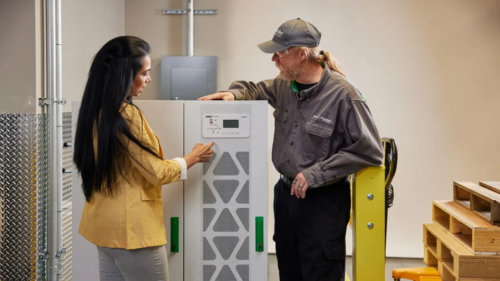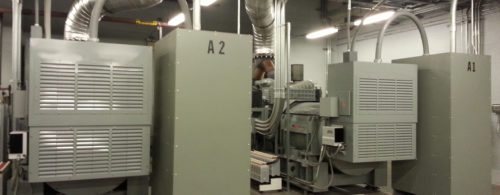The True Story of Electric Christmas Lights (As Told by NECA)
Electric Christmas lights gained popularity after World War II, due in part to the extension of electrification throughout rural America in the 1940s. However, like so much else in the history of electricity, the glowing holiday displays we now enjoy began with Thomas Edison.
First, a disclaimer: A persistent legend credits Ralph Morris as the inventor of electric Christmas lights. The story goes that Morris, in a panic at seeing his son push a candle over on a Christmas tree, singed his own hair and nearly set the tree on fire rushing to the rescue. Legend has it that Morris then came up with the idea of pulling the lights from an old telephone switchboard and wiring them on a tree, thereby “inventing” the electric Christmas tree lights. This incident is true, but it happened in 1908–more than a quarter century after a close associate of Edison’s actually did the inventing.
So, what really happened? It all began in 1882, just three years after the incandescent bulb was invented. Edward Johnson, Edison’s friend and partner in the Edison Illumination Company in New York City, hand-wired 80 Detroit Post and Tribune witnessed the event and filed this report:
“Last evening I walked over beyond Fifth Avenue and called at the residence of Edward H. Johnson, vice-president of Edison’s electric company. There, at the rear of the beautiful parlors, was a large Christmas tree presenting a most picturesque and uncanny aspect. It was brilliantly lighted with many colored globes about as large as an English walnut and was turning some six times a minute on a little pine box. There were eighty lights in all encased in these dainty glass eggs, and about equally divided between white, red and blue. As the tree turned, the colors alternated, all the lamps going out and being relit at every revolution. The result was a continuous twinkling of dancing colors, red, white, blue, white, red, blue–all evening. I need not tell you that the scintillating evergreen was a pretty sight–one can hardly imagine anything prettier. The ceiling was crossed obliquely with two wires on which hung 28 more of the tiny lights; and all the lights and the fantastic tree itself with its starry fruit were kept going by the slight electric current brought from the main office on a filmy wire. The tree was kept revolving by a little hidden crank below the floor which was turned by electricity. It was a superb exhibition.”
Despite the report in the Detroit paper, few Americans heard of electric Christmas lights until 1895, when President Grover Cleveland commissioned a White House tree lighted with Edison bulbs. The large evergreen featured more than a hundred multicolored lights.
Not long afterwards members of high society began hosting Christmas tree parties. These were grand events since a typical lighted tree of the early 1900s cost upwards of $300 (more than $2,000 in today’s dollars), including the generator and wireman’s services.
Smaller and less expensive battery-operated lighting strings decorated the trees of those adventurous enough to do the wiring. An article in Popular Electricity Magazine described the wiring process and provided instructions on ordering the necessary wire, sockets and light bulbs. General Electric even offered miniature light bulbs for rent in some cities as an alternative to an outright purchase of the expensive lamps. However, such trees were still out of range for the average American family of the era.
General Electric first made electric tree lighting more affordable in 1903 when the company offered a pre-assembled lighting outfit for the first time. Still expensive at $12, many department stores in the larger, electrified cities would rent outfits for the season for $1.50. Called a “festoon,” the outfit consisted of eight green pre-wired porcelain sockets, eight Edison miniature base colored glass lamps, and a handy screw-in plug for easy attachment to a nearby wall or ceiling light socket. However, GE was unable to patent their festoon, leaving the market open for anyone to manufacture the strings.
More About Electric Christmas Tree Lights
The person responsible for popularizing Christmas tree lighting is Albert Sadacca. In 1917, when the continuing practice of lighting trees with candles caused a tragic fire in New York City, 15-year-old Albert had an idea.
Sciacca’s family had a novelty business selling wicker cages with imitation birds that lit up. Albert suggested that this parents begin making electric lights for Christmas trees. It was a good idea, but only one hundred strings of electric Christmas tree lights sold in the first year. Business increased dramatically, however, when Albert proposed painting the bulbs red, green, and other colors instead of using plain glass.
Albert eventually started NOMA Electric Company with his brothers Henri and Leon. Their multi-million dollar business was the largest Christmas lighting company in the world prior to 1965.
Public distribution of electricity was not common in the early 20th century. People living outside of major cities who wanted one of these illuminated trees had to supply their own electric power, usually from household generators. Electric socket outfits had not been invented, and this meant that all of the tree lights had to be wired by hand. Wiremen were generally hired to complete the tedious task of wiring the lights necessary to illuminate a room-sized tree.
In the beginning of the century, American homes were wired for lighting circuits only, with only a single light bulb socket in each room. Any additional electrical devices had to be powered from the ceiling outlet; wall outlets did not exist. The earliest Christmas lighting outfits used screw-in current taps from the ceiling. As electricity became more popular, outlets for wall lighting were added which made adding electric lights the Christmas tree easier.
In fact, the familiar bladed wall plug used today developed from a device originally used to facilitate the interconnection of Christmas light strings. Some prototypes of this device were used as early as 1917. It was patented as the “Tachon” connector in 1924. The 1924 Tachon started out as a screw-in type of connector with a safety cover, but soon evolved into the two parallel blade type.
Many of the earliest Christmas lights burned so hot that they were about as dangerous as the candles they were advertised to replace.
Many of the earliest figural light bulbs representing fruit, flowers and holiday figures were blown in molds that were also used to make small glass ornaments. These figural lights were painted by toy makers.
Most figural Christmas lights were made out of milk glass for a specific reason. The paint used on the lights did not adhere well to glass, and as the lights were turned on and off, the constant expansion and contraction of the glass helped the paint to flake off even faster. It was discovered that milk glass looks better than clear glass when the lights have flaking paint, so the industry quickly and almost exclusively switched over to the use of the white milk glass by the late 1920s.
A common but incorrect belief in the early days of electric Christmas lighting was that Christmas light bulbs would burn longer in an upright position. Early decorators spent a lot of time making sure that the lamps were positioned upright on the tree.
True outdoor Christmas lights were not introduced to the public until 1927 — almost 45 years after the first electric tree lights were demonstrated. Some sets were sold as outside units before 1927, but they were small, dangerous and extremely impractical for the average family.
In 1927, General Electric introduced outdoor lighting outfits that consisted of seven lamps wired in parallel so that the failure of a single lamp would not affect the rest. The earliest of these lights were round; by 1928, they had taken the familiar swirled or flame shape. General Electric and various Edison Electric distribution companies sponsored neighborhood “decorating with color-light” contests in an effort to induce sales of the new outfits.
The bell-shaped lights offered by General Electric in 1932 were originally designed as pint-sized streetlights for a model train station manufactured by the Lionel Company. But when it was discovered that they also resembled Christmas bells when hung upside down, GE offered them in festive colors as Christmas lights. They remained popular until the advent of World War II. (A working string of these antique lights now commands $5000.)
The miniature lights we use today are wired exactly the same way as our grandparents’ lights were–in series. This means that if one goes out, they all should go out. What is different about today’s lights is the fact that each little bulb has a shunt device in it, which prevents the string from going dark due to the failure of one or more lamps. The shunt device can only work if the lamp stays in its socket.
Do you have experience and expertise with the topics mentioned in this content? You should consider contributing to our CFE Media editorial team and getting the recognition you and your company deserve. Click here to start this process.




